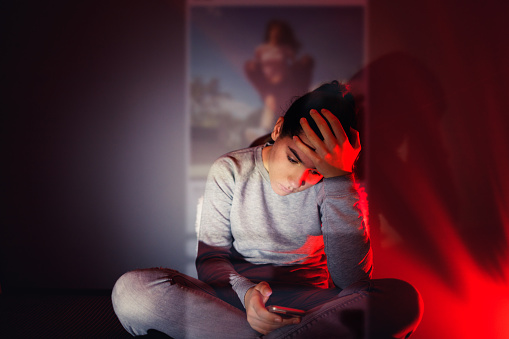Social media overdose impacts teenagers’ mental health

Indians on average spend about 2.25 hours on social media daily, slightly below the global average of 2.5 hours (Photo: Unsplash)
Even though the social media platforms have been undergoing rapid growth in various parts of the world, notably India, the enforced lockdowns saw a huge increase of 70 pc. Indians on average, spend about 2.25 hours on social media daily, slightly below the global average of 2.5 hours a day.
The number of social media users has grown consistently and even in the year 2021 to 448 million, boosted mainly by the wide use of smartphones across India, while the number of Internet users has grown to around 624 million, covering roughly 45 pc of the total population of India. Teenagers and adolescents in the age group of 13-19 years, constitute 31 pc of total social media users in India, according to data website, Statista.
A teenager from Bangalore shares with Media India Group his day-to-day life, as how he spends his whole day using mobile.
“My day starts with using social media, mostly Instagram and WhatsApp by checking status and watching videos. I have a habit to check my phone every two minutes. In a day I spend around 3 hours in social media and around 8 to 9 hours in total by playing games. The time limits have increased during the pandemic,” Pradeep, 19, from Bangalore tells Media India Group.
According to a report released in 2019 by Common Sense Media teenagers spend an average of seven hours and 22 minutes on their phones a day. YouTube, Instagram, and Snapchat are the most common social media platforms for teens.
“I have no other work to do, my day starts with using phone and ends in the same way. I hardly spend 3 hours in other activities like doing household works or other works, and rest of my time I spend on social media mainly watching streaming videos. My phone distracts me the most but it is also difficult for me to stay away from it,” another teenager, Shivani, 17, a resident of Delhi, tells Media India Group.
Social media affects teens’ mental health
Several studies have shown that prolonged use of social media may be related to the signs and symptoms of depression as well as low self-esteem, especially in children.
Overuse of social media can also affect the brain, as it is particularly sensitive during the adolescence. Additionally, teenagers are more susceptible to peer pressure, cyberbullying and they go through many other challenges in the online world which makes them lose self-esteem and isolated.
“When anything is consumed in excess, it obviously can be harmful to ourselves. The biggest problem in teen age is the constant comparison. Teens are obsessed to compare themselves with others. The most disappointing thing is that they don’t even compare themselves with the people around them but with the people on social media who they might even not met,” Dr Rashi Agarwal, a psychiatrist from Meerut, Uttar Pradesh, tells Media India Group.
“If everyday a teenager sees some serious idealistic body standards, or something other typically, mentally they try to evolve into that and they feel more uncomfortable with their own body. This sometimes leads to feel a lot of body image issues, eventually leading to body dysmorphic disorder also on a daily basis, where they start comparing themselves every day. It is a stage of starting and affects everything which eventually leads to clinical anxiety and depression as they try to peruse the idealistic standards in their life too.” she says.
A survey also found that 70 pc of the teens hide their online behavior from their parents. “We are not an open culture and everybody is living their own life. The teenagers are not controlled by anyone in their family and that is the reason they don’t have a fear of being caught if they did something wrong. That is the main reason many teens do unusual activities on social media and face lots of problems,” says Agarwal.
Bengaluru-based teenager Pradeep agrees with Agarwal. “My parents never check my phone and they are really not aware of what I do on social media. During the entire duration of the pandemic and lockdowns, I hardly came of my room. I am not comfortable in speaking and sharing my personal life with my own family members as much as I do in social media with my friends,” he says.
“There are two brain centres, one is the prefrontal cortex that is the analytical centre. Second is the limbic system that is the emotional centre. Various studies show that functionally and in maturity, the limbic system matures faster than than the prefrontal cortex. Thus when adolescents take decisions, often they may take it in the impulse mode or emotionally, rather than on the analytical basis since the prefrontal cortex is not yet fully developed or mature in most adults. Specifically, when you are on social media and everything just passes in the blink of an eye, there is very little time to take analytical decisions and you usually give in to your impulses and emotions rather than taking analytical decisions,” says Agarwal.
According to a Pew Research Centre report on the effect of social media on teenagers, 26 pc of teens say that social media makes them feel worse about their own life.
“People who have low self-esteem and have less friends and also less contact with the real world, they have more tendency to be addicted to social media because somewhere social media validates their emotions. The feeling that they get through the social media must be apparently what they could not find in the real world,” says Agarwal.
The rising number of social media users has led to many other problems, of which cyberbullying, harassments and photo-morphing are the most common issues now a days.
“It’s a sad reality, but women are the main victims of such humiliation and harassment on social media. I know of many such cases, and specifically those people who have an open account face lots of problems. Their pictures have been morphed and they have received a lot of unwanted messages, even I am also the part of this as a victim,” says Agarwal.
Social media has increased the incidence of depression, because many of those who are addicted to it or have been harassed online do not interact with others and they also don’t feel comfortable sharing their experiences or problems.
“Even though filter is just a normal thing on today’s social media, but many of those who use filters are not comfortable with their own skin. Because of all these issues, teenagers try to harm themselves, because they feel that they don’t like the people that they want to be,” says Agarwal
“The constant fear of missing out or fomo makes them feel that they are not doing enough when compared to others in social media. At such times a person starts over thinking and engages in reckless activities for the purpose of just to do like others,” warns Agarwal.
“I feel discomfort and a kind of isolation when there is no social media or internet. As I was used to it, I know I have much better work to do but I procrastinate everything, just to be able to use the phone,” says Shivani.
“Teenagers should have an open conversation with their parents and parents should be aware that this is an illness and it is not a lack of will power or some issues that can’t be dealt with. Specifically, the child should not be blamed if they have such problems,” says Agarwal.
‘‘Many teenagers who come seeking help to distract themselves from their addiction of using smartphone for long hours, we usually ask them to undertake their hobbies instead in order to distract themselves and the most effective solution is, everyone should use screen time apps. It would definitely help everyone to have a certain limit on the time spent on the phone,” adds Agarwal.











